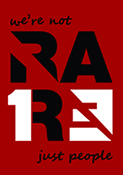ERIN MACBEAN
Erin MacBean
How long have you been living with GIST?
14 years
What was your first thought when you were diagnosed with GIST?
“Life will never be the same again.” The second time (when it came back and after a few choice words) it was, “This is not any easier hearing this the second time around.”
What do you do?
I’m a full-time volunteer patient advocate. I’m a pediatric GIST representative and Science Team member for the Life Raft Group and I am also a board member and editor-in-chief of the Pheo Para Troopers – a patient organization for pheochromocytoma and paraganglioma.
How are you doing now?
I was just told that I now have metastatic GIST in my liver as well as some more other tumors that have plagued my life since I was a teen, but I’m okay. I live life fully and am optimistic that a cure (or better treatment) is just around the corner.
GIST is called a “rare” cancer, how do you feel about that term being applied to you?
I have had Carney Triad since I was the age of 16. Carney Triad involves three “rare” tumors: GIST, Paraganglioma, and Pulmonary Chondroma. It’s considered super “rare” as only 140 people have ever had it. Only 35 have ever gotten all three types – I’m one of those 35. These tumors are supposed to be “rare” to show up in kids, “rare” to behave the way they do in me, “rare” to be located in the areas my tumors were found.
I hate the term “rare.”
Rare means a 16-year-old has to spell her tumor name to her doctors because they never heard of it. Rare means less doctors understand it, and less research is done, so less hope for a cure. Rare means that I hold less value because I am not in a group that affects a large population. Rare means I am one voice screaming, “What about me? I’m a person too!” in a stadium filled and unified in a chant of commonality.
GIST doesn’t make you rare…but what makes you unique?
Being a writer and researcher while living with tumors has made me unique because I can be the bridge between many types of groups. Whether it’s from childhood cancer survivors – to adult cancer survivors, one type of cancer – to another type, or even from a patient’s perspective – to a scientific researcher’s perspective, I am able to use my words and experiences to help those groups understand one another. I was put in a unique position, and I hope I can help others because of it.

